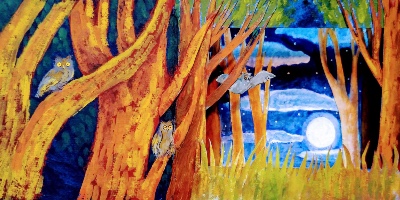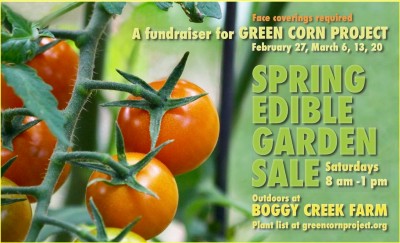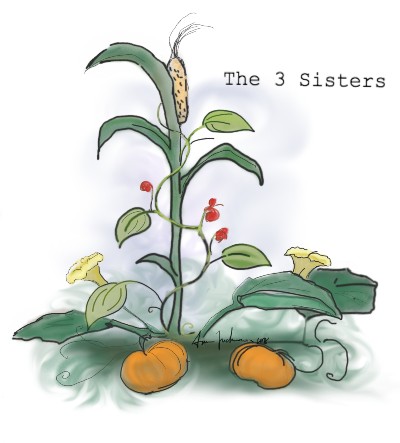
bringing nature, nurseries and gardeners together March 19, 2021
|
|
While out gardening this week, I kept thinking of a funny scene created by the 1970s UK comedy troupe Monty Python. In 'The Parrot Sketch' a dissatisfied customer tries to return a dead parrot to this pet shop, and comical arguments ensue as the shop clerk stands by his claim that the bird is not dead, but merely resting.
As I walked around my garden, I realized that some plants were definitely dead (RIP prickly pears, mission and arbequena and Mexican olives, rosemary, mirror leaf viburnum, and on and on), while others, which I had thought of as deceased, were quietly extending out their delicate green tendrils into the spring afternoons, showing that all along they had merely been 'resting.'
Salvia amistad, silver bush germander, Mrs. Gonzales rose, and my American smoke tree have all been pleasant surprises - and a welcome contrast to the rest of my garden, which remains a stubborn shade of brown. 'Hope that you've had some pleasant surprises too. - Darrel Mayers ❦

Owls in the wood: Windsor Park artist Linda Anderson writes: "I have been hearing lots of screech owls lately as the weather is nice and we open the windows at night. Lots of birds hanging out in the old Sycamore." ❦
________________________________________________
Three articles to help you and your plants during this difficult time of recovery.
Your garden in general: Diane Kirby: Statesman
Your grass: Texas Gardener Magazine
Your trees: TreeFolks ❦
 A note from the City: If you have lots of clippings and branches from the Feb snow/ice storm, you can drop them off at the Hornsby Bend Biosolids Management Plant (2210 FM 973) any day of the week until April 3, 8 a.m.–5 p.m., Tip: bring some binoculars; it's also a fine place for bird-watching. Brush drop-off ❦
________________________________________________
People from the Clouds: Austin Organic Gardeners went international recently, with a wide-ranging lecture by Dr. Sam Beauysta Lazer, speaking live from Oaxaca, Mexico. Corn is intricately woven into a mystical belief system of his Zapotec tribe that takes the crop way beyond just being food. "Corn is our spiritual connection, that connects heaven to earth," he said. View his presentation here: People from the Clouds ❦

Two veggie sales this weekend: on Saturday support the Green Corn Project by buying young veggie plants at Boggy Creek Farm from 8 a.m. to 1 p.m. Green Corn / On Sunday support Austin Organic Gardeners by buying plants from them. You can place your order on-line, and pick up your plants from 3 locations in these zip codes: 78702, 78748 and 78753. Complete details here: A.O.G. ❦

Save Hancock from privatization: Please take 2 mins to take a city-wide survey on the future of Hancock Golf Course. For the question "What would you prefer the space at Hancock Golf Course be used for?" let's let the City know loud and clear that that we want an open greenspace and parkland. PARD's Hancock Survey Many thanks. ❦
_______________________________________________
Central Texas Gardener: Bernardine and Conrad Bering have cultivated a lot of gardeners since they opened Barton Springs Nursery in 1986 with the motto "Grow Plants for Travis County in Travis County." With fun, passion, dedication, and long, hard hours, they’ve changed our philosophical landscape. Watch Linda's touching interview here: KLRU - YouTube ❦
 Companion Planting: is it a Real Solution or an Old Garden Myth? by Amanda Moon The idea of having two or more plants growing next to each other to the mutual benefit of each has been around for thousands of years. Beyond this basic concept, it is actually more controversial than one might anticipate. (But then isn’t everything these days!) Research shows that certain plants emit compounds and chemicals that create positive and negative growing environments for their surrounding neighbors. Many assumptions are also derived from years of pass-along information (that usually accompanies pass-along plants) and cultural traditions. So although there aren't many agreed-upon, hard and fast rules, here are some do’s and don’ts that have a good chance of being beneficial to you and your plants. It is good practice for gardeners to mix different plant groups and families together, no matter the situation. When you grow just one type of plant, you have a monoculture on your hands, which is a problem. Diseases and insects are given a free buffet to feast upon with no break in the action. Biological diversity in the plant or animal kingdom is the key to a healthy ecosystem – from a large farm to a small raised planter bed. Mixing different plants and seasonal crop rotation helps to keep nematodes at bay around tomatoes and others in the nightshade family. It also keeps Brassicas from attracting every caterpillar-creating moth and butterfly from miles away, and stops blight from spreading like wildfire through your garden. Planting garlic around your roses is another good habit. This piece of advice has been around forever and has scientific and folkloric merit. University studies have shown that garlic keeps aphids at bay. They may also help to control thrips and make the roses more fragrant. The best approach? Plant a border of society garlic or garlic chives near the roses. Onion chives don’t do so well here, but the other two will give you years of rose protection, flowers and of course some culinary uses. If we look back through history, we find the concept of companion planting to be central to success of the 'the Three Sisters.' This is the corn, beans and squash trio that Native American tribes have cultivated for thousands of years. The corn acts as a 'trellis' for the beans, and the beans stabilize the corn and add nitrogen to the soil when they decay, feeding the soil for the next generation of crops. The running squash shades and cools the soil, keeping moisture stable allowing for the corn and beans to thrive even in the heat of the summer. Purslane is another ground-cover vegetable that can have a similar role to the squash. This tasty salad green can be seeded under taller crops to act as living mulch. This little 'noxious weed' is actually high in Omega-3 fatty acids and beta carotene. Basil has been said to have a positive effect on tomatoes, both in keeping away aphids and tomato hornworms (fingers crossed!) while improving the flavor of the tomato. Whether completely true or not, the two make a great side-by-side combination in the garden and on the table, and are therefore well worth experimenting with. There is some evidence that marigolds (genus Tagetes) can help to keep aphids away from the garden. To do this the scent would need to be quite strong (Copper Canyon daisy for example) and closely set for there to be much benefit. On the other hand, they seem to attract spider mites like crazy so . . . this may be more myth than fact. But there's one fact we can be sure of: planting rue next to some plants, especially basil, can cause them to decline and even die. Rue is an excellent butterfly larvae plant and deserves a place in the garden, but think of it as the anti-companion plant and plan accordingly! Just remember . . . never be afraid to experiment with garden folklore advice, keep your garden rich in its variety, and happy planting! ❦ |
 It's About Thyme Legacy Publications.
Contact newsletter editor Darrel Mayers with any ideas for articles or interesting links at internationalrain@yahoo.com (hitting 'reply' to this email won't work) |
|
|